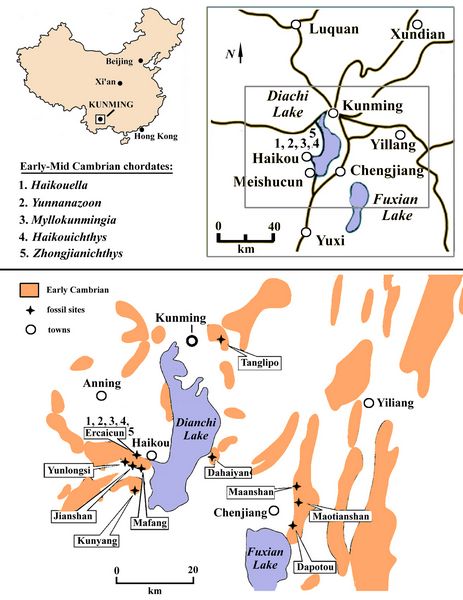Athena Review Image Archive ™
Chengjiang biota near Kunming, Yunnan, China

Kunming, Maotianshan shales (after Shu 2003)
Lower Cambrian deposits in the Maotianshan shales of Yunnan Province in southern China have revealed a number of early chordates and other complex organisms, dating from 525-520 mya. Kunming is a local town near the find sites of several early chordate fossils. The Maotianshan shales are named for Maotianshan Hill in Chengjiang County in Yunnan Province, renouned for its fine-grained shale with superb fossil preservation. It is thus ranked as a Lagerstätten, from German lager, “storage” and stätte, “place,” as is the Burgess shale in British Columbia.
Discoveries began with 1984 discovery of the Early Cambrian naraoiid Misszhouia, a soft-bodied relative of trilobites Since then the Maotianshan shales deposits have revealed thousands of soft-bodied fossils, known as the Chengjiang fauna, making it one of the world’s most important localities for understanding the evolution of early multi-cellular life, particularly members of the phylum Chordata.
The Chengjiang biota, believed to have been mainly benthic (bottom-living), has all animal groups found in the Burgess Shale, yet is ten million years older. Thus metazoans must have diversified earlier or faster in the early Cambrian than previously known. At least eight primitive chordates have been indentified, including Haikouella, Yunnanzoon, Myllokunmingia, Haikouichtys, and Zhongjianichthys, all found in the Ercaicun beds on the west side of Dianchi Lake (see fig.).
Myllokunmingia is possibly a very primitive agnathid or jawless fish, dating from 535-520 mya (Shu 2003). The related species Haikouichthys ercaicunensis (“Haikou fish from Ercaicun”) has a distinct head showing gills with filaments, and a neural chord (Chen, Huang, and Li 1999). The enigmatic Yunnanozoon lividum is considered to be the earliest hemichordate, possibly a cephalochordate (something like a modern lancelet), providing an anatomical link between invertebrates and chordates (Chen and Huang 2008). Haikouella lanceolata is the earliest known craniate-like chordate. This fish-like animal has many similarities to Y. lividum, but also differs in several aspects. It has a discernible heart, dorsal and ventral aorta, and gill filaments (Chen, Huang, and Li 1999).
References:
Chen, Huang, and Li 1999. Nature 402, pp.518-522.
Shu, Degan 2003. A Paleontological perspective of vertebrate origin. Chinese Science Bulletin 48, pp.725-735.
Copyright © 1996-2020 Rust Family Foundation (All Rights Reserved).